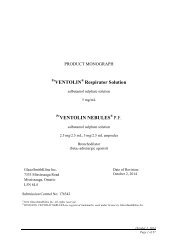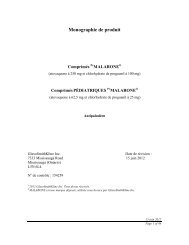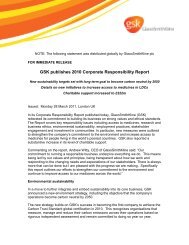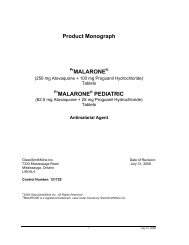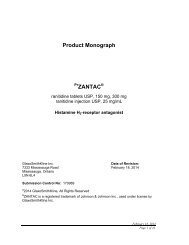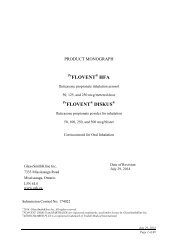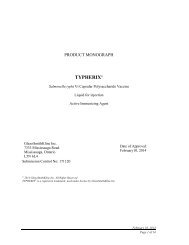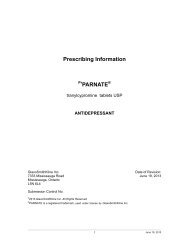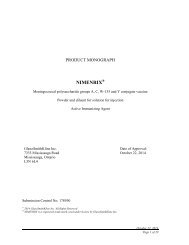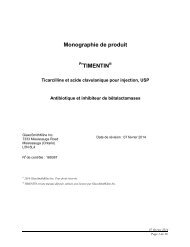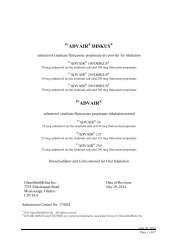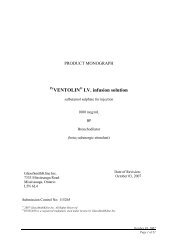PRODUCT MONOGRAPH IMITREX DF IMITREX ... - GlaxoSmithKline
PRODUCT MONOGRAPH IMITREX DF IMITREX ... - GlaxoSmithKline
PRODUCT MONOGRAPH IMITREX DF IMITREX ... - GlaxoSmithKline
You also want an ePaper? Increase the reach of your titles
YUMPU automatically turns print PDFs into web optimized ePapers that Google loves.
MutagenicitySumatriptan produced no detectable or reproducible mutagenic potential above that seenin controls, in studies conducted in vitro with mutant strains of Salmonella typhimurium,Escherichia coli, or Saccharomyces cerevisiae with or without a rat hepatic drugmetabolizing enzyme system. In addition, no statistically significant clastogenic effectswere seen in vitro using cultured human peripheral lymphocytes at a maximum dose of1000 μg/mL in the presence of the rat hepatic drug metabolism enzyme system or in vivoin a rat micronucleus test, at a maximum dosage of 1000 mg/kg.Sumatriptan showed only weak cytotoxic activity at the highest concentration of5000 μg/mL tested in vitro with V-79 mammalian cells.Reproduction and TeratologyIn organogenesis studies, oral doses of up to 500 mg/kg/day in the rat were withoutadverse effects upon fetal parameters measured, but an oral dose of 1000 mg/kg/day inthe rat proved toxic to both dams and embryos.Two oral organogenesis studies were conducted in rabbits, one using daily oral doses of5, 25 or 100 mg/kg/day and the other using 5, 15 or 50 mg/kg/day. Sumatriptan wasadministered from days 8-20 of pregnancy.In the first study, there were no adverse effects at the two lower doses. At the highestdose (100 mg/kg), there was a severe decrease in maternal body weight gain indicatingthat this dose is maternally toxic. A non-significant increase in post-implantation intrauterinedeath from 8.3% in the untreated control group to 21.2% in the high-dose(background range in untreated control animals 1.7% - 15.2%) was observed. In additionthere was an increased incidence of subtle variations in the position of certain bloodvessels emanating from the aortic arch. In the untreated control these were present at5.5% of fetuses (3 out of 10 litters affected). At the maternally toxic dose of 100 mg/kg,23.1% of fetuses had these variations (4 out of 5 litters affected). This type of change iscommonly found in untreated control animals (historical control incidence 17.5%;proportion of litters affected 44 out of 91), and does not compromise either health orsurvival.In the second oral study, the findings were similar to those seen in the first study. Therewere no adverse effects at the two lower doses. At the highest dose (50 mg/kg), therewas a severe decrease in maternal body weight gain. There were also various fetal effectsascribed to maternal toxicity. There was a slight reduction in mean fetal weight (37.7 gin control, 35.3 g at 50 mg/kg); small increases in the incidence of common skeletalvariants (control incidence 8.8%; at 50 mg/kg 20.8%; background mean 6.2%;background range 1.3% - 13.3%) and again an increased incidence of positional changesof certain aortic arch blood vessels; (control incidence 12.8%, 3 out of 20 litters affected;at 50 mg/kg 25%, 10 out of 14 litters affected).Placental transfer studies in pregnant rabbits have shown that sumatriptan can cross theplacental barrier in small amounts. After a 5 mg/kg oral dose, 71.2 ng sumatriptan perOctober 21, 2014Page 37 of 58



